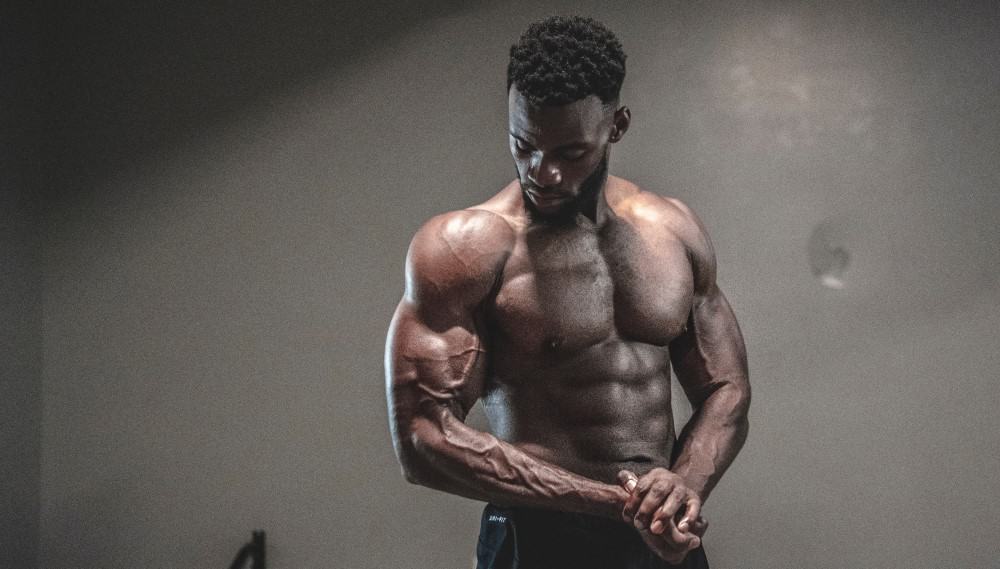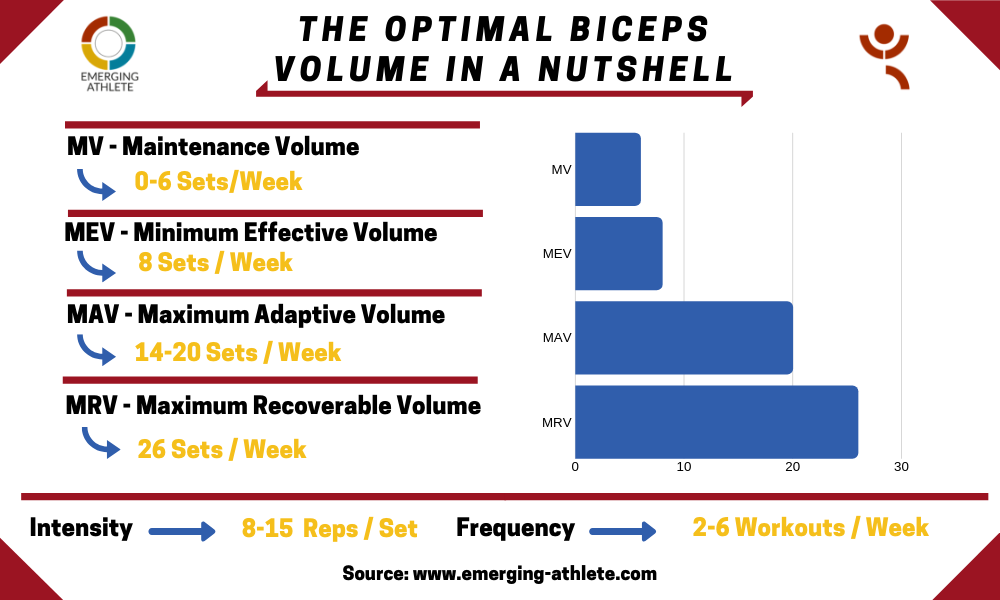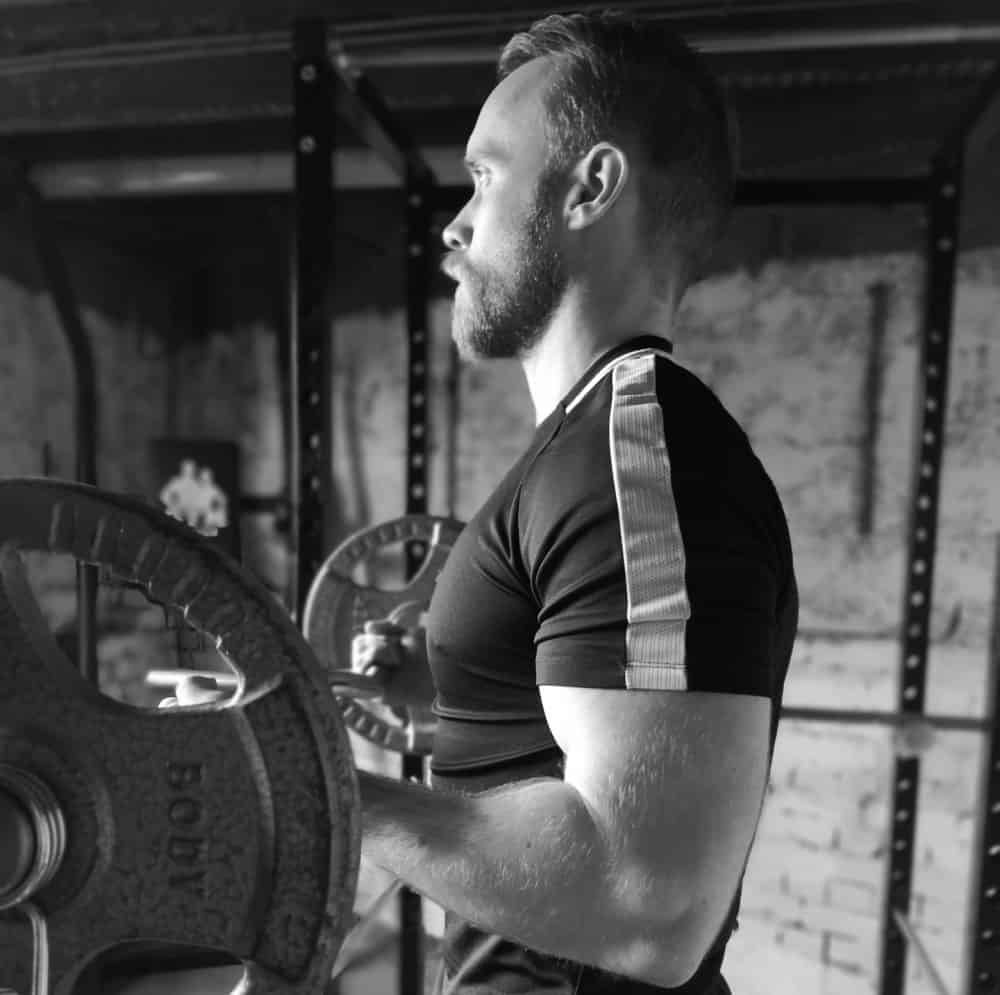In the last article, we talked about the optimal triceps volume, if you haven’t checked it out yet definitely give it a read.
2/3 of our arms are composed of the triceps. So, why would you not want to know everything for optimal triceps growth? 😉
But I know you’re all waiting for this article. Today its time for presumably the most admired “bromuscle”.
Obviously, I am talking about quads… Just kidding, of course, its the biceps.
For that reason, we’re going more in-depth about the optimal biceps volume to eliminate all your current excuses and complaints such as “my biceps does not want to grow”, “I am curling so much weight but I still have a small biceps..”.
If you still have any question about volume, check out our complete guide about the optimal volume for hypertrophy.
Alright, in case this is the first article that you’re reading from our volume series, I’ll briefly give you an overview.
What can you expect from this article series?
Based on Dr. Mike Israetel’s knowledge, our own experience from longstanding training as well as working with clients, we want to clarify the most important aspects of muscle hypertrophy.
So, guys, let’s dive into one if not the most famous and beloved muscle.
Have you ever seen guys who look relatively casual, just started working out but standing in front of the mirror swinging biceps curls with 20kg dumbbells?
Of course, you do, they’re in every gym…
But does their arms look like properly curling 20kg dumbbells?
Most likely not.

So, what is my point that I want to make here?
Biceps training doesn’t really work like that. Since it is a relatively small muscle, training heavy and intense is only recommend up to a certain degree, but that’s relative anyway.
Please throw your ego out of the door and only use weights that you can control correctly.
This has some striking benefits.
Firstly, doing isolation exercises with heavy weight and flawed execution can result in injuries.
Secondly, you can use the full range of motion whilst activating more muscles fibers as compared to making use of momentum, so-called cheat curls.
Overall, a proper range of motion leads to increased muscle growth.
Thirdly, the biceps is a small muscle. You just don’t need tons of isolation work to grow it.
Since most of the programs include a lot of heavy back exercises like pull-ups or bent over rows. These already accumulate a lot of volume, so with too much isolation work, it’s likely that your biceps gets only heavily fatigued.
If that sounds like you, don’t worry. It’s good that you’re here now.
In the following, I’ll explain to you everything you should keep in mind when it comes down to the optimal biceps volume.
MV – Maintenance Volume
What does MV mean?
MV stands for Maintenance Volume and refers to the amount of work that is required to maintain the muscle’s current size.
Why is it important to know your MV?
This is important because in case you have to fall back from training for any particular reason, you don’t want to lose your hard acquired gains, do you?
Besides, after plenty of heavy workouts in between your MAV and MRV or even above your MRV, it is for sure a good thing to lower your volume every now and then.
Therethrough, your body becomes desensitized for better growth in the future.
For that reason, it is crucial to know where your MV lies to ensure you muscle maintenance, as well as adhere to the appropriate volume in your “deload phase”.
For more information on deloads, I wrote a whole article about it, just click the highlighted link to read more.
What’s the MV for the optimal biceps volume?
MV: 0-4-6 sets/week
The maintenance volume here is located between 0-4-6 sets/week.
Now, some of you might be confused.
How can 0 sets/week be possible to maintain your biceps gains?
Well, people who are more or less intermediate and/or whose training program includes a lot of pulling exercises don’t need tons of isolation biceps work.
All these pulling movements fatigue and demand the biceps quite heavily.
Accordingly, it is possible that you’re able to maintain your current biceps size without any additional biceps volume.
This is handy if you think about it. Means, you can save some time and spend that on other important things.
For bodybuilders who already have big biceps and who’re training their biceps with higher volume, the whole thing looks differently.
The MV for these folks lies somewhere at 4-6 sets/week.
In practice, this could look like it follows. You could do 3 sets of barbell curls on Monday followed by 3 sets of cable curls on Thursday and still maintain your muscles size.
MEV – Minimum Effective Volume
What does MEV stand for?
The Minimum Effective Volume stand for the minimum amount of work that is required to stimulate muscle hypertrophy.
Why is it important to know your MEV?
To put it simply, as well as it is important to know how much volume your biceps need to keep its current size, it is at least of similar importance to know how much volume is required to grow your biceps, isn’t it?
How does the MEV volume benchmark look like?
MEV: 8 sets/week
On average, most folks obtain good growth with around 8 sets/week.
Everything below 8 sets/week possibly does not result in good growth at all.
Therefore I recommend you to stay with at least 8 sets/week.
Again, here applies the same as for the MV value.
If your program includes a lot of heavy pulling exercises (pull-ups, bent over rows…) you don’t need to do infinite isolation work for your biceps.
Eventually, we can say that the heavier pulling exercises you do, the less additional isolation work you need for your biceps.
MAV – Maximum Adaptive Volume
What does MAV mean?
The Maximum Adaptive Volume gives you a good indication of how much volume is most likely to stimulate the best growth.
Why is it important to know your MAV?
Do you want to train all the time with the least effective volume?
Certainly not, right?
For proper muscle growth, we need to put more effort into our workout and increase the volume steadily.
Hence, it is important to know where your MAV lies to maximize your muscle growth.
Where can we set a point of reference for the biceps MAV?
MAV: 14-20 sets/week
This is presumably the area where on average most of the muscle growth happens.
Why do I say presumably?
As always, it varies individually. Some may be totally fine with a volume of 14 direct sets/week whereas others even need more than 20 sets/week to stimulate any biceps growth at all.
But on average most folks will get good growth with a volume between 14-20 sets/week.
Ultimately, you can only figure out where your optimal biceps volume lies by trying out different volumes and adjust your program gradually.
MRV – Maximum Recoverable Volume
What does MRV mean?
The Maximum Recoverable Volume is largely important. It refers to the maximum amount of work your body can actually fully recover.
This means if you overreach your MRV it is likely that your body needs more and more time to recover. Ultimately, your performance might suffer from that.
Why is it important to know your MRV?
Pretty obviously, nobody wants to take a forced break due to excessive volume.
Therefore, it is essential to know where your MRV lies to keep your body recovered and avoid superfluous breaks.
What is a good volume that is still recoverable?
MRV: 20-26 sets/week
This is the average for most individuals but keep in mind, we’re talking about landmarks not perfectly individualized values. With this in mind, there are and will always be exceptions.
Maybe you’re an individual who can endure 32 sets/week and still get away fine. On the other hand, another person might only be able to handle 15 sets/week before their biceps literally feels like falling off.
Why is there a quite big range between 20-26 sets/week?
The heavier pulling exercises you do, the less additional isolation work is needed to grow your biceps.
Thereout it can be abstracted that the actual volume correlates with your current training program and the “passive” biceps involvement.
Frequency
How often should and can I train for the optimal biceps volume?
2–6 workouts/week
We can reveal a big difference between people whose biceps gets fatigued relatively fast/slow.
The biceps is a relatively small muscle and can sustain a higher frequency with around 3-4 times/week.
Most folks gain the best benefits from 3-4 biceps workouts/week. You can even increase the frequency for your biceps volume but in the end, you have to adjust the frequency according to the volume.
A lower volume would mean that you can possibly work with a higher frequency BUT it is not the most productive way to train biceps every day with low volume.
I would recommend working out 3-4 times/week with biceps involvement.
Furthermore, I can suggest training biceps relatively heavy once and adjust the other two sessions. For example, doing a bit higher volume and lower intensity to make sure that your back workout doesn’t suffer from that.
Intensity
After we’ve covered which parameter requires which volume and the frequency, the question arises:
how hard should we train?
On average 8-15 reps with challenging weight
What does that mean?
Certainly, you can go lower than 8 reps/set but as already mentioned earlier, isolation movements with heavy weights can easily result in injury.
You’re better off leaving the heavy forces to compound exercises (e.g. pull-ups) with 5-8 reps or heavy rows which already demand your biceps vigorously.
Some individuals sustain with 15 reps or even higher, but higher than 15 reps is presumably not the best thing to do. This fatigues the biceps and limits your training even if you still have power left.
That’s why I would recommend staying in between 8-15 reps on average for the optimal biceps volume.
But these aren’t fixed values, you should use them as a starting point from where on you figure out which volume works best for you and adjust it gradually.
Now and then you can try out different rep ranges in your workouts during the mesocycles.
For example, for a certain time, you’re targeting the biceps relatively heavy with around 8 reps and after that, in your next cycle, you switch to 12-15 reps. With that tactic, you’ll get the benefits of both rep ranges and likely stimulate as much growth as possible.
Biceps workout – Exercises
When talking about the optimal biceps volume, we also need to take a closer look at the practice side of the coin not just the theory.
Some classic and common exercises are:
- Barbell Curls
- Dumbbell Curls
- Cable Curls (variations)
- Machine Curls
One of my favourite exercises for biceps is barbell curls.
Why?
Briefly speaking, you can train your biceps heavily with barbell curls. Rep ranges around 8-12 will definitely give you a great pump and stimulate massive growth.
I really like to use barbell curls as a heavy isolation movement and afterwards finish off my biceps workout with a lighter machine or cable curl exercise.
Range of motion
Full range of motion is a really good idea for biceps!
To make it comprehensive, the biceps has a couple of functions.
First, supinate which means turning your wrist with an outside movement.
Second, flex your forearm and lastly, flex your shoulders.
On that note, you should at least take your curls all the way up and down. It is scientifically proven that a full range of motion works well for biceps.
Therefore, at this point, we can refer back to what I said at the beginning of this article.
Keep your ego outside the gym and stop doing cheat curls.
Use weights that you can control and go with the full range of motion.
Your biceps will thank you after!
Thank me later, guys.
Variation
A good thing to do for biceps workout is to implement some variation for either the rep range or the total volume.
For example, you could vary the rep range you’re using in between your mesocycles.
First, you start off with relatively heavy reps around 8 and after 4-5 weeks you switch to a higher rep range with 10+ reps.
The other approach could look like this: you adjust your biceps volume to your back volume. This means the heavier pulling exercises and general back workouts you have per week, the less additional isolation work is necessary.
The same principle applies as with the first one. You could start your first mesocycle with a relatively high volume and then switch to a lower volume (increased intensity) in your mesocycle. But again, this needs to be adjusted to your current training program (especially back workout frequency & intensity).
I can definitely recommend changing some small things now and then to assess how your body responds to new ways of training. Eventually, it’s also more interesting for you instead of sticking to the same plan day in and day out.
Conclusion
Let’s recap what you should keep in mind.

Exercises: The biceps consists of two heads: the long and the short head.
If you want to have a fully developed biceps, you need to pay attention to both heads!
Range of motion: Definitely use the full range of motion when it comes down to biceps workout. This is a good idea because the biceps has a couple of important functions.
It supinates (means turning your wrist with an outside movement), it flexes your forearm and shoulders. Furthermore, science has proven that a full range of motion results in enhanced biceps growth.
Variation: Definitely do some changes every so often. You can either vary your total volume according to your program or the intensity.

Practical Tips
Drop sets: You start with a certain weight (do as many reps as you can) lower the weight about 25% (again, do as many reps as you can) and lower again about 25%. This really results in a crazy pump!
If you want to go more in-depth about drop sets, just check out the link. It will lead you to a separate article that I wrote on that topic.
Supersets: One of the most common training techniques. You first start off either with a heavy isolation exercise (e.g. barbell curls) and then instantly followed by another lighter isolation movement (e.g. cable curls). The other way around works as well means starting with the lighter isolation exercise and then going heavier.
Same goes for supersets, if you’re interested click the link and give it a read, thanks.
Special shout-out to Dr. Mike Israetel, we really value his knowledge and the content that he shares with you guys on his YT channel and his blog.
Definitely check out his video about biceps volume!
I hope this article answers all your questions about the optimal biceps volume.
If you still have any further questions, feel free to contact us via our social media channels or just leave a comment below!
So, guys, what was the most interesting thing that you learned with this article? How does your biceps workout look like?
I am curious, let us know in the comment section below!
Cheers,
Claas





1 thought on “The Optimal Biceps Volume – Hypertrophy Guide”
Pingback: The Optimal Triceps Volume - Hypertrophy Guide - Emerging Athlete